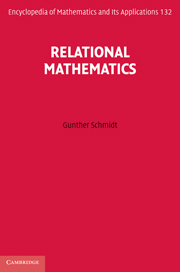Book contents
- Frontmatter
- Contents
- Notes on illustrations
- Preface
- 1 Introduction
- PART I REPRESENTATIONS OF RELATIONS
- PART II OPERATIONS AND CONSTRUCTIONS
- PART III ALGEBRA
- PART IV APPLICATIONS
- PART V ADVANCED TOPICS
- Appendix A Notation
- Appendix B Proofs postponed from Part II
- Appendix C Algebraic visualization
- Appendix D Historical annotations
- References
- Symbols
- Index
PART II - OPERATIONS AND CONSTRUCTIONS
Published online by Cambridge University Press: 05 May 2013
- Frontmatter
- Contents
- Notes on illustrations
- Preface
- 1 Introduction
- PART I REPRESENTATIONS OF RELATIONS
- PART II OPERATIONS AND CONSTRUCTIONS
- PART III ALGEBRA
- PART IV APPLICATIONS
- PART V ADVANCED TOPICS
- Appendix A Notation
- Appendix B Proofs postponed from Part II
- Appendix C Algebraic visualization
- Appendix D Historical annotations
- References
- Symbols
- Index
Summary
At this point of the book, a major break in style may be observed. So far we have used free-hand formulations, not least in HASKELL, and have presented the basics of set theory stressing how to represent sets, subsets, elements, relations, and mappings. However, so far we have not used relations in an algebraic form.
From now on, we shall mainly concentrate on topics that inherently require some algebraic treatment. We cannot start immediately with formal algebraic proofs and with the relational language TituRel in which all this has been tested. Rather, we first present Part II, which is full of examples that demonstrate the basics of algebraic rules. Whenever one of these early rules needs a proof, this proof will be very simple, but nevertheless omitted at this point. The postponed proofs can be found in Appendix B.
We will, however, often show how point-free versions, i.e., those hiding quantifiers and individual variables, are derived from a predicate-logic form. These deductions are definitely not an aim of this book. However, they seem necessary for many researchers who are not well trained in expressing themselves in a point-free algebraic manner. These deductions are by no means executed in a strictly formal way. Rather, they are included so as to convince the reader that there is a reason to use the respective point-free construct.
- Type
- Chapter
- Information
- Relational Mathematics , pp. 33 - 34Publisher: Cambridge University PressPrint publication year: 2010



